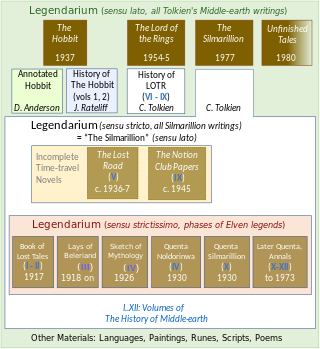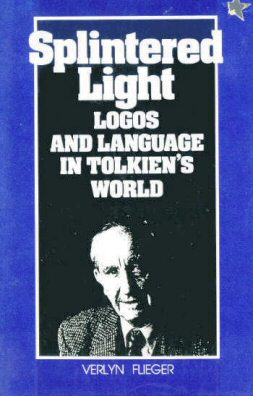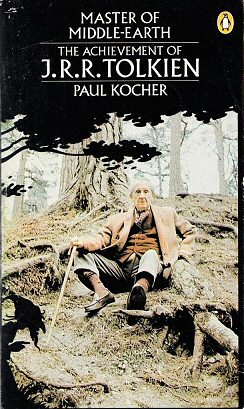
Thomas Alan Shippey is a British medievalist, a retired scholar of Middle and Old English literature as well as of modern fantasy and science fiction. He is considered one of the world's leading academic experts on the works of J. R. R. Tolkien about whom he has written several books and many scholarly papers. His book The Road to Middle-Earth has been called "the single best thing written on Tolkien".
The Notion Club Papers is an abandoned novel by J. R. R. Tolkien, written in 1945 and published posthumously in Sauron Defeated, the 9th volume of The History of Middle-earth. It is a time travel story, written while The Lord of the Rings was being developed. The Notion Club is a fictionalization of Tolkien's own such club, the Inklings. Tolkien's mechanism for the exploration of time is through lucid dreams. These allow club members to experience events as far back as the destruction of the Atlantis-like island of Númenor, as narrated in The Silmarillion.
The following outline is provided as an overview of and topical guide to the real-world history and notable fictional elements of J. R. R. Tolkien's fantasy universe. It covers materials created by Tolkien; the works on his unpublished manuscripts, by his son Christopher Tolkien; and films, games and other media created by other people.
The term Middle-earth canon, also called Tolkien's canon, is used for the published writings of J. R. R. Tolkien regarding Middle-earth as a whole. The term is also used in Tolkien fandom to promote, discuss and debate the idea of a consistent fictional canon within a given subset of Tolkien's writings.
The works of J. R. R. Tolkien have generated a body of research covering many aspects of his fantasy writings. These encompass The Lord of the Rings and The Silmarillion, along with his legendarium that remained unpublished until after his death, and his constructed languages, especially the Elvish languages Quenya and Sindarin. Scholars from different disciplines have examined the linguistic and literary origins of Middle-earth, and have explored many aspects of his writings from Christianity to feminism and race.

Tolkien's legendarium is the body of J. R. R. Tolkien's mythopoeic writing, unpublished in his lifetime, that forms the background to his The Lord of the Rings, and which his son Christopher summarized in his compilation of The Silmarillion and documented in his 12-volume series The History of Middle-earth. The legendarium's origins reach back to 1914, when Tolkien began writing poems and story sketches, drawing maps, and inventing languages and names as a private project to create a unique English mythology. The earliest story drafts are from 1916; he revised and rewrote these for most of his adult life.

The History of The Hobbit is a two-volume study of J. R. R. Tolkien's 1937 novel The Hobbit. It was published by HarperCollins in May and June 2007 in the United Kingdom, with both volumes released in the United States by Houghton Mifflin on 21 September 2007; a boxed set combining The Hobbit with The History of The Hobbit was released on 26 October 2007. A single-volume edition was released on 27 October 2011.

J. R. R. Tolkien: Author of the Century is a 2001 book of literary criticism written by Tom Shippey. It is about the work of the philologist and fantasy author J. R. R. Tolkien. In it, Shippey argues for the relevance of Tolkien today and attempts to firmly establish Tolkien's literary merits, based on analysis of The Hobbit, The Lord of the Rings, The Silmarillion, and Tolkien's shorter works.

J. R. R. Tolkien's fantasy books on Middle-earth, especially The Lord of the Rings and The Silmarillion, drew on a wide array of influences including language, Christianity, mythology, archaeology, ancient and modern literature, and personal experience. He was inspired primarily by his profession, philology; his work centred on the study of Old English literature, especially Beowulf, and he acknowledged its importance to his writings.

The Silmarillion is a collection of myths and stories in varying styles by the English writer J. R. R. Tolkien. It was edited and published posthumously by his son Christopher Tolkien in 1977, assisted by the fantasy author Guy Gavriel Kay. It tells of Eä, a fictional universe that includes the Blessed Realm of Valinor, the once-great region of Beleriand, the sunken island of Númenor, and the continent of Middle-earth, where Tolkien's most popular works—The Hobbit and The Lord of the Rings—are set. After the success of The Hobbit, Tolkien's publisher Stanley Unwin requested a sequel, and Tolkien offered a draft of the writings that would later become The Silmarillion. Unwin rejected this proposal, calling the draft obscure and "too Celtic", so Tolkien began working on a new story that eventually became The Lord of the Rings.

A Companion to J. R. R. Tolkien is a 2014 book edited by Stuart D. Lee and published by Wiley-Blackwell. It is a part of the Blackwell Companions to Literature series, which have been described as prestigious reference works, and features authors well-known in the field of Tolkien studies.

J. R. R. Tolkien's maps, depicting his fictional Middle-earth and other places in his legendarium, helped him with plot development, guided the reader through his often complex stories, and contributed to the impression of depth and worldbuilding in his writings.
Tolkien's Middle-earth family trees contribute to the impression of depth and realism in the stories set in his fantasy world by showing that each character is rooted in history with a rich network of relationships. J. R. R. Tolkien included multiple family trees in both The Lord of the Rings and The Silmarillion; they are variously for Elves, Dwarves, Hobbits, and Men.
Tolkien's monsters are the evil beings, such as Orcs, Trolls, and giant spiders, who oppose and sometimes fight the protagonists in J. R. R. Tolkien's Middle-earth legendarium. Tolkien was an expert on Old English, especially Beowulf, and several of his monsters share aspects of the Beowulf monsters; his Trolls have been likened to Grendel, the Orcs' name harks back to the poem's orcneas, and the dragon Smaug has multiple attributes of the Beowulf dragon. The European medieval tradition of monsters makes them either humanoid but distorted, or like wild beasts, but very large and malevolent; Tolkien follows both traditions, with monsters like Orcs of the first kind and Wargs of the second. Some scholars add Tolkien's immensely powerful Dark Lords Morgoth and Sauron to the list, as monstrous enemies in spirit as well as in body. Scholars have noted that the monsters' evil nature reflects Tolkien's Roman Catholicism, a religion which has a clear conception of good and evil.

A Tolkien Compass, a 1975 collection of essays edited by Jared Lobdell, was one of the first books of Tolkien scholarship to be published; it was written without sight of The Silmarillion, published in 1977. Some of the essays have remained at the centre of such scholarship. Most were written by academics for fan-organised conferences. The collection was also the first place where Tolkien's own "Guide to the names in The Lord of the Rings" became widely available.

Splintered Light: Logos and Language in Tolkien's World is an 1983 book of literary criticism by the leading Tolkien scholar Verlyn Flieger, in which she argues that light is a central theme of Tolkien's Middle-earth mythology, in particular in The Silmarillion. It has been admired by other scholars to the extent that it has become a core element of Tolkien scholarship.

Tolkien's Art: 'A Mythology for England' is a 1979 book of Tolkien scholarship by Jane Chance, writing then as Jane Chance Nitzsche. The book looks in turn at Tolkien's essays "On Fairy-Stories" and "Beowulf: The Monsters and the Critics"; The Hobbit; the fairy-stories "Leaf by Niggle" and "Smith of Wootton Major"; the minor works "Lay of Autrou and Itroun", "The Homecoming of Beorhtnoth", "Imram", and Farmer Giles of Ham; The Lord of the Rings; and very briefly in the concluding section, The Silmarillion. In 2001, a second edition extended all the chapters but still treated The Silmarillion, that Tolkien worked on throughout his life, as a sort of coda.

Master of Middle-earth: The Fiction of J. R. R. Tolkien, alternatively subtitled The Achievement of J.R.R. Tolkien, is a 1972 book of literary criticism of J. R. R. Tolkien's Middle-earth fantasy writings, written by Paul H. Kocher, and one of the few to be published in Tolkien's lifetime. It focuses especially on The Lord of the Rings and The Hobbit, and also covers some of his minor works such as "Leaf by Niggle" and "Smith of Wootton Major".

J. R. R. Tolkien created a dilemma for himself with his supposedly evil Middle-earth peoples like Orcs when he made them able to speak. This meant they were sentient and open to morality, like Men. In Tolkien's Christian framework, that in turn meant they must have souls, so killing them would be wrong without very good reason. If he wanted killing them not to be such a problem, then they had to be non-sentient and without any moral sense, like ordinary animals. Both Tolkien and other scholars have been aware of the contradiction implied by this position: if Orcs were essentially "beasts", then they should not have had a moral sense; if they were corrupted Elves, then treating them as "other" to be slaughtered was straightforward racism. Tolkien made repeated attempts to resolve the dilemma.
In Tolkien's legendarium, ancestry provides a guide to character. The apparently genteel Hobbits of the Baggins family turn out to be worthy protagonists of The Hobbit and The Lord of the Rings. Bilbo Baggins is seen from his family tree to be both a Baggins and an adventurous Took. Similarly, Frodo Baggins has some relatively outlandish Brandybuck blood. Among the Elves of Middle-earth, as described in The Silmarillion, the highest are the peaceful Vanyar, whose ancestors conformed most closely to the divine will, migrating to Aman and seeing the light of the Two Trees of Valinor; the lowest are the mutable Teleri; and in between are the conflicted Noldor. Scholars have analysed the impact of ancestry on Elves such as the creative but headstrong Fëanor, who makes the Silmarils. Among Men, Aragorn, hero of The Lord of the Rings, is shown by his descent from Kings, Elves, and an immortal Maia to be of royal blood, destined to be the true King who will restore his people. Scholars have commented that in this way, Tolkien was presenting a view of character from Norse mythology, and an Anglo-Saxon view of kingship, though others have called his implied views racist.














